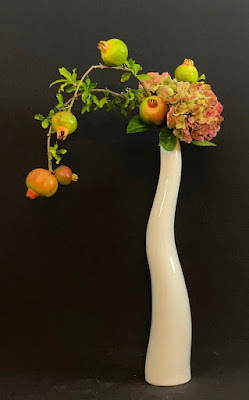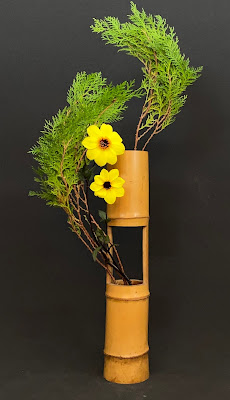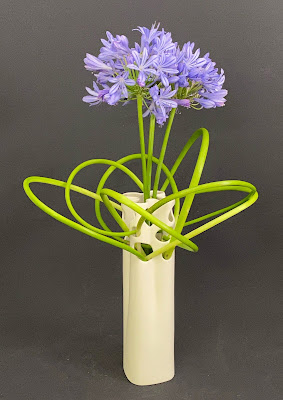 |
| With leaves only |
Hello all,
Most of my ikebana is opportunistic, that is, I arrange materials that become available at the time and, often, I make more than one arrangement, more or less, workshopping the material. However, as a teacher, I need to go back to basics and practice some of the themes that I don't instinctively gravitate towards. Case in point is the above arrangement - 'With leaves only'. I used 6 different types of leaves - hostas, cana lilies, calla lilies, curculigo, bromeliad and fish bone fern (nephrolepis).
I also made the arrangement, below, for the same reason. The theme is 'Using a variety of materials'. The inspiration came from my vegetable garden, where some of my herbs are going to seed and had to be cut back. I used oregano, mint, amaranthus, oleander, alstroemeria psittacina, fish bone fern, cosmos and night blooming jasmine (Cestrum).
I used a tsubo vase in which I wedged a cross fixture and used only one of the 'wedges' created by the fixture. It's not visible in the photograph but, by using the back, right hand wedge, the material stay upright and there is space around the lip of the container. In this arrangement lightness is very important.

Classes resumed last week and I was delighted to see my students after such a long time. We all appreciate what we have, much more, now and take things less for granted than before the pandemic.
The theme I set for the advanced students was 'Mass, line and colour in two containers'. I specified that I did not want them to use either agapanthus or hydrangeas because it would be too easy to get a mass with those flowers. I wanted them to create their own mass. Below is my arrangement in which I used alstroemeria psittacina seed heads and crucifix orchids in matching ceramic containers.
Jenny did the next one. She used two different coloured chrysanthemums, nandina domestica nana and umbrella grass stems in ceramic containers.
Next is Nicole's arrangement and she used crepe myrtle flowers, nandina domestica nana and painted willow stems for the lines in two, very interesting, ceramic containers.
And Vicky did the next one in two large, boat shaped suibans, using marigolds and umbrella grass stems.
Lucy's arrangement was very difficult to photograph successfully. I have a white and a black background for photos. When using the black background, the kiwi vine was lost and when using the white, the containers are less visible. Also, I could not capture the shadow of the stem over the water, which was Lucy's specific intention.
Bredenia came to class with the same containers as me and was concerned that some might think she was copying me. Absolutely not! She had no way of knowing what I used before she came to class.
While I'm on the subject of Bredenia, I'd like to mention that she works for 'Breastscreen Victoria'. She makes ikebana arrangements for the room at work, where she speaks to clients and, often, has to impart unpleasant news. She has just the right temperament for such an important and difficult job. The arrangements are very helpful as people are interested and ask questions, which help to break the ice. The other staff are also very appreciative of Bredenia's work.
In her arrangement, Bredenia used cathedral begonia leaves and bamboo.
Maren is close to finishing Book 5. Her theme was 'Preparing for a future Exhibition'. We concentrated on secure mechanics, so that the arrangement could withstand any accidental knock by the public. She used a lichen covered, dry branch and alstroemerias in a ceramic container that she used for the first time.
Lei's curriculum lesson was 'Emphasising Lines at the Base'. She used palm leaves, which she trimmed, asparagus fern and belladonna lilies in a ceramic container
Wendy's curriculum lesson was 'Freestyle arrangement using two containers'. She used rose hip stems and two different coloured roses in matching, ceramic containers.
I don't, normally, include basic arrangements in this blog but I was very pleased with Dianne's 'Variation No.6 Horizontal' and felt it deserved a place.





































